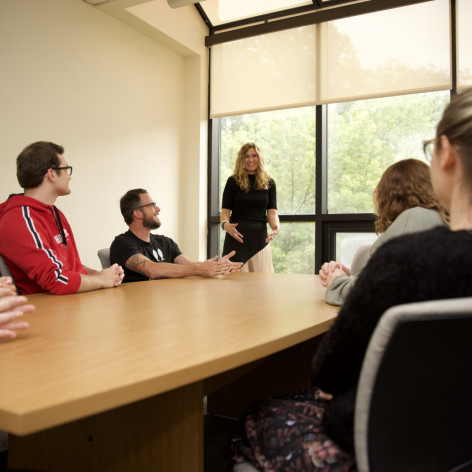Huntington students return to Mississippi for cleanup
FOR RELEASE: Monday, April 16, 2007
Huntington, Ind.-For those who were not affected directly, the horror and devastation of Hurricane Katrina is like a distant memory. News coverage is almost non-existent. The faces of victims no longer are plastered on magazine covers. It is assumed that life has returned to normal. Over spring break, three Huntington University staff members and 22 students witnessed how far from normal life on the Gulf Coast still is. "We had gone to Mississippi in January for J-Term," said Martha Smith, associate dean of students. "The Gulf Coast will need help for a long, long time, especially east Biloxi, which has a great deal of poverty in this specific area."
Hands On Gulf Coast, based in Biloxi, was once again host for this trip. In January, this same organization had the name Hands On USA. Hands On Gulf Coast rented a community building to house students who volunteered their time to relief efforts.
Matthew Schownir, a sophomore history major from Huntington Ind., didn't have very high expectations when first approached by friends to join the trip to Mississippi.
"I figured I'd have a good time over spring break with familiar faces and a warmer climate," Schownir said. "Then I think God slapped me in the spiritual face and made me realize that this was going to be something bigger than just me. I was going there to help people."
Cassie Rudy, a sophomore elementary and special education major from Huntington Ind., had an idea of what to expect. Rudy had been to Biloxi twice before the spring break trip.
"I feel like my heart is called to service in that area," said Rudy. "Any chance I get to go, I do!"
While on the trip students did such jobs as cutting and nailing siding, painting, working with children at an elementary school, volunteer at a Boys and Girls club, and cooking for up to 100 other volunteers at the site.
Students like Schownir and Rudy all experienced somewhat of the same schedule while in Biloxi. Each day began with breakfast 7 a.m., and students in a construction crew left by 7:30. Lunch was served by the Salvation Army, and between 5-6 p.m. everyone was back at the community building. Dinner was served at 6:30 with a meeting about that day's activities following. Quiet hours began at 9:30 and lights out was at 10 p.m. so that everyone had a good night's sleep before waking up and doing it all over again.
The Biloxi trip not only challenged the students physically but spiritually as well. The Huntington students shared the Hands On Gulf Coast building with students from many different colleges, most of them non-Christian. This proved to be one of the biggest challenges at the beginning of the week for the students.
"I think it was difficult for students," Smith said. "But as the week went on students began to want to get to know them better, to reach out to them as Christ would want us to."
Being surrounded by non-Christians also gave the students a sense of hope for the situation they were helping with.
"The great part about the trip for my spiritual life is the realization that, as people loving others, Christians aren't fighting the battle alone," said Schownir. "Though we may not all be under the same banner, I have more hope for the world after going to Biloxi."
Cassie Rudy felt the same way.
"I was spiritually affected by the love that non-Christians can show in their actions and through their service," said Rudy.
Even though there has been progression in the clean-up efforts, there is still a lot of work to be done.
"It was reported to us that the recovery could take 10 to 15 years," said Smith. "What is worse is that it takes up to 100 years for psychological recovery. There are still many people living in FEMA trailers."
For Schownir and Rudy describing the devastation that they witnessed can not be expressed in words.
"The destruction is too unique for words, and the pictures don't do it justice either," said Rudy. "The best way to see what Biloxi is like is to visit."
"We definitely saw an improved picture than what was on the news a year and a half ago," said Schownir. "Yes, the conditions have improved, and life is starting to return to normal, but it's a long way to normal. It's a sad picture, but not a hopeless one."



